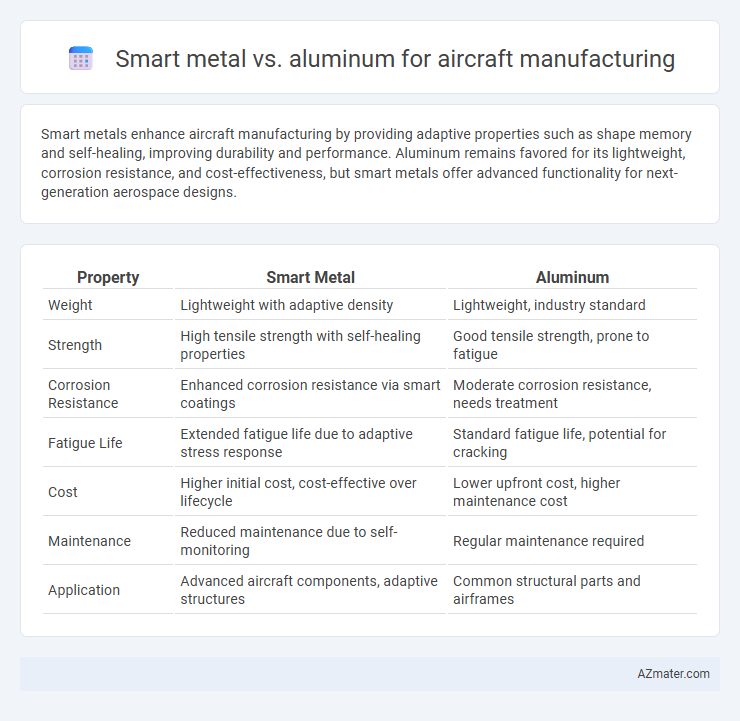Smart metals enhance aircraft manufacturing by providing adaptive properties such as shape memory and self-healing, improving durability and performance. Aluminum remains favored for its lightweight, corrosion resistance, and cost-effectiveness, but smart metals offer advanced functionality for next-generation aerospace designs.
Table of Comparison
| Property | Smart Metal | Aluminum |
|---|---|---|
| Weight | Lightweight with adaptive density | Lightweight, industry standard |
| Strength | High tensile strength with self-healing properties | Good tensile strength, prone to fatigue |
| Corrosion Resistance | Enhanced corrosion resistance via smart coatings | Moderate corrosion resistance, needs treatment |
| Fatigue Life | Extended fatigue life due to adaptive stress response | Standard fatigue life, potential for cracking |
| Cost | Higher initial cost, cost-effective over lifecycle | Lower upfront cost, higher maintenance cost |
| Maintenance | Reduced maintenance due to self-monitoring | Regular maintenance required |
| Application | Advanced aircraft components, adaptive structures | Common structural parts and airframes |
Introduction: Evolution of Aircraft Materials
The evolution of aircraft materials has shifted from traditional aluminum alloys to advanced smart metals that offer enhanced strength-to-weight ratios and adaptive properties. Smart metals, such as shape memory alloys and titanium-based composites, provide superior corrosion resistance and fatigue performance compared to conventional aluminum used in early aircraft structures. This transition supports improved fuel efficiency, durability, and overall aircraft performance in modern aerospace engineering.
Defining Smart Metals in Modern Aviation
Smart metals in modern aviation refer to advanced alloys and materials with embedded sensors or adaptive properties that enhance aircraft performance, safety, and maintenance. These metals, often integrated with aluminum or titanium, respond to environmental changes by altering their mechanical properties or providing real-time data on structural integrity. Their ability to self-heal, detect stress, or adjust stiffness makes them critical in reducing weight and improving fuel efficiency compared to traditional aluminum alloys.
Aluminum: The Traditional Choice in Aircraft Manufacturing
Aluminum remains the traditional choice in aircraft manufacturing due to its excellent strength-to-weight ratio, corrosion resistance, and cost-effectiveness. Its malleability allows for easy fabrication and repair, making it ideal for structural components and skins in commercial and military aircraft. Compared to smart metals, aluminum's well-established supply chain and extensive testing history continue to support its dominant role in aerospace production.
Weight-to-Strength Comparison: Smart Metals vs Aluminum
Smart metals, such as titanium alloys and advanced composites, offer superior weight-to-strength ratios compared to traditional aluminum used in aircraft manufacturing. Titanium alloys provide high tensile strength and corrosion resistance at a fraction of the weight of steel, allowing for lighter airframes without compromising structural integrity. Aluminum remains popular due to its lower cost and ease of fabrication, but smart metals enable improved fuel efficiency and performance through enhanced strength-to-weight optimization in modern aerospace applications.
Corrosion Resistance and Durability
Smart metals, such as titanium alloys and advanced composites, exhibit superior corrosion resistance compared to traditional aluminum alloys used in aircraft manufacturing due to their stable oxide layers and higher resistance to environmental degradation. While aluminum offers lightweight properties beneficial for fuel efficiency, it is more susceptible to corrosion, requiring protective coatings and maintenance to ensure durability. The enhanced durability and corrosion resistance of smart metals contribute to longer aircraft service life and reduced maintenance costs, making them increasingly preferred in modern aerospace engineering.
Manufacturing Process and Cost Implications
Smart metals, such as shape memory alloys, offer enhanced mechanical properties and adaptability in aircraft manufacturing but require complex processing techniques like precise heat treatment and specialized machining, increasing production complexity and costs. Aluminum remains favored due to its lightweight nature, easier fabrication, and cost-efficiency, benefiting from well-established manufacturing processes like extrusion, forging, and machining. Comparing cost implications, aluminum alloys generally result in lower material and processing expenses, while smart metals drive higher initial investments but can reduce maintenance and improve performance over the aircraft lifecycle.
Impact on Aircraft Performance and Fuel Efficiency
Smart metal alloys, engineered with embedded sensors and adaptive properties, enhance structural integrity and real-time damage detection, significantly improving aircraft performance by reducing maintenance downtime. Aluminum, traditionally favored for its lightweight and corrosion resistance, offers excellent fuel efficiency through weight reduction but lacks the advanced adaptability of smart metals. Integrating smart metals in aircraft manufacturing optimizes aerodynamic performance and lowers fuel consumption by enabling proactive stress management and material optimization during flight.
Repairability and Maintenance Considerations
Smart metal alloys exhibit superior self-healing properties and corrosion resistance, significantly reducing downtime for repairs in aircraft manufacturing. Aluminum, while lightweight and widely used, demands more frequent maintenance due to susceptibility to fatigue and corrosion, increasing operational costs. Advanced smart metals also enable easier detection of structural issues through embedded sensors, streamlining maintenance workflows and enhancing aircraft longevity.
Environmental Impact and Sustainability
Smart metals, such as shape memory alloys, offer superior durability and reduced maintenance needs compared to aluminum, potentially lowering the environmental footprint over an aircraft's lifecycle. Aluminum, widely used due to its lightweight properties and recyclability, requires significant energy-intensive processing, contributing to higher carbon emissions during production. Emphasizing the use of smart metals can enhance sustainability by minimizing resource consumption and extending the operational lifespan of aircraft components.
Future Trends: Will Smart Metals Replace Aluminum?
Smart metals, integrating embedded sensors and adaptive properties, offer enhanced durability, real-time structural monitoring, and weight reduction compared to traditional aluminum in aircraft manufacturing. Future trends indicate increasing adoption of smart metals due to their ability to improve safety, reduce maintenance costs, and optimize performance in aerospace applications. While aluminum remains dominant for its lightweight and cost-effectiveness, smart metals are poised to complement or partially replace aluminum as manufacturing technologies advance and material costs decrease.

Infographic: Smart metal vs Aluminum for Aircraft manufacturing
 azmater.com
azmater.com